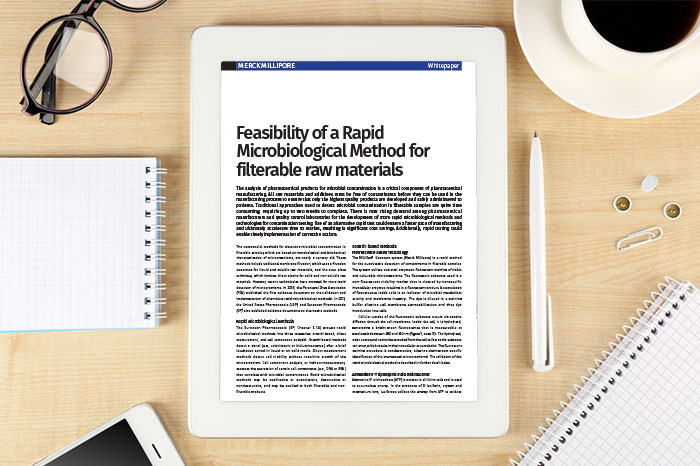Whitepaper: Feasibility of a Rapid Microbiological Method for filterable raw materials
Posted: 15 January 2016 | Merck Millipore | No comments yet
The Milliflex® Quantum system (Merck Millipore) is a rapid method for the quantitative detection of contaminants in filterable samples…
The analysis of pharmaceutical products for microbial contamination is a critical component of pharmaceutical manufacturing. All raw materials and additives must be free of contaminants before they can be used in the manufacturing process to ensure that only the highest quality products are developed and safely administered to patients. Traditional approaches used to detect microbial contamination in filterable samples are quite time consuming, requiring up to two weeks to complete. There is now rising demand among pharmaceutical manufacturers and quality control laboratories for the development of more rapid microbiological methods and technologies for contamination testing. Use of an alternative rapid test could ensure a faster pace of manufacturing and ultimately accelerate time to market, resulting in significant cost savings. Additionally, rapid testing could enable timely implementation of corrective actions.
The compendial methods for detecting microbial contamination in filterable samples, which are based on morphological and biochemical characterisation of microorganisms, are nearly a century old. These methods include traditional membrane filtration, which uses a filtration apparatus for liquid and soluble raw materials, and the pour plate technique, which involves direct plating for solid and non-soluble raw materials. However, recent technologies have emerged for more rapid detection of microorganisms. In 2000, the Parenteral Drug Association (PDA) published the first guidance document on the validation and implementation of alternative rapid microbiological methods. In 2012, the United States Pharmacopeia (USP) and European Pharmacopeia (EP) also published guidance documents on alternative methods.
This whitepaper is restricted - login or subscribe free to access


Why subscribe? Join our growing community of thousands of industry professionals and gain access to:
- bi-monthly issues in print and/or digital format
- case studies, whitepapers, webinars and industry-leading content
- breaking news and features
- our extensive online archive of thousands of articles and years of past issues
- ...And it's all free!
Click here to Subscribe today Login here
Related content from this organisation
- Bioavailability enhancement services market to exhibit 11 percent CAGR
- Pharmaceutical membrane filtration market to value $10 billion by 2025
- Whitepaper: Product characterisation: reveal your molecule earlier, faster and with accuracy
- Expert View: What ADC evolution means for manufacturing
- Solution stable trypsin at HPLC 2018






